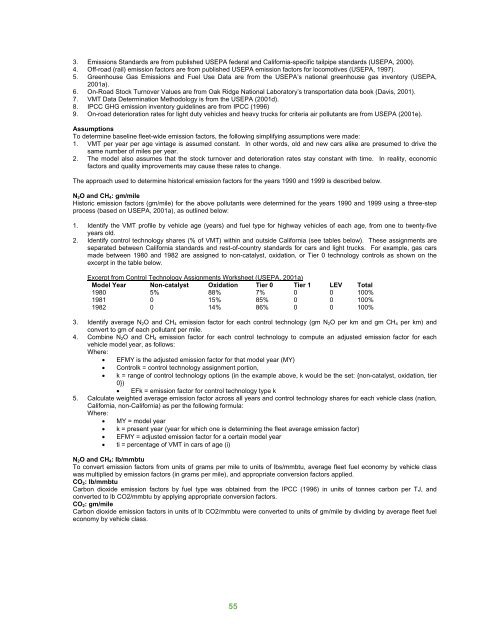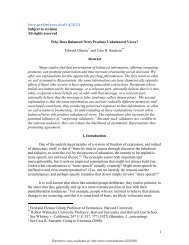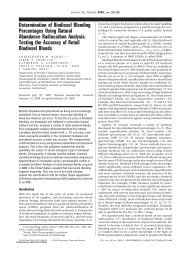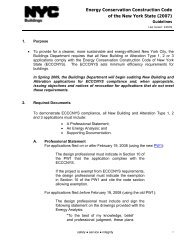GREENHOUSE GAS EMISSIONS - The Sallan Foundation
GREENHOUSE GAS EMISSIONS - The Sallan Foundation
GREENHOUSE GAS EMISSIONS - The Sallan Foundation
You also want an ePaper? Increase the reach of your titles
YUMPU automatically turns print PDFs into web optimized ePapers that Google loves.
3. Emissions Standards are from published USEPA federal and California-specific tailpipe standards (USEPA, 2000).<br />
4. Off-road (rail) emission factors are from published USEPA emission factors for locomotives (USEPA, 1997).<br />
5. Greenhouse Gas Emissions and Fuel Use Data are from the USEPA’s national greenhouse gas inventory (USEPA,<br />
2001a).<br />
6. On-Road Stock Turnover Values are from Oak Ridge National Laboratory’s transportation data book (Davis, 2001).<br />
7. VMT Data Determination Methodology is from the USEPA (2001d).<br />
8. IPCC GHG emission inventory guidelines are from IPCC (1996)<br />
9. On-road deterioration rates for light duty vehicles and heavy trucks for criteria air pollutants are from USEPA (2001e).<br />
Assumptions<br />
To determine baseline fleet-wide emission factors, the following simplifying assumptions were made:<br />
1. VMT per year per age vintage is assumed constant. In other words, old and new cars alike are presumed to drive the<br />
same number of miles per year.<br />
2. <strong>The</strong> model also assumes that the stock turnover and deterioration rates stay constant with time. In reality, economic<br />
factors and quality improvements may cause these rates to change.<br />
<strong>The</strong> approach used to determine historical emission factors for the years 1990 and 1999 is described below.<br />
N 2 O and CH 4 : gm/mile<br />
Historic emission factors (gm/mile) for the above pollutants were determined for the years 1990 and 1999 using a three-step<br />
process (based on USEPA, 2001a), as outlined below:<br />
1. Identify the VMT profile by vehicle age (years) and fuel type for highway vehicles of each age, from one to twenty-five<br />
years old.<br />
2. Identify control technology shares (% of VMT) within and outside California (see tables below). <strong>The</strong>se assignments are<br />
separated between California standards and rest-of-country standards for cars and light trucks. For example, gas cars<br />
made between 1980 and 1982 are assigned to non-catalyst, oxidation, or Tier 0 technology controls as shown on the<br />
excerpt in the table below.<br />
Excerpt from Control Technology Assignments Worksheet (USEPA, 2001a)<br />
Model Year Non-catalyst Oxidation Tier 0 Tier 1 LEV Total<br />
1980 5% 88% 7% 0 0 100%<br />
1981 0 15% 85% 0 0 100%<br />
1982 0 14% 86% 0 0 100%<br />
3. Identify average N 2 O and CH 4 emission factor for each control technology (gm N 2 O per km and gm CH 4 per km) and<br />
convert to gm of each pollutant per mile.<br />
4. Combine N 2 O and CH 4 emission factor for each control technology to compute an adjusted emission factor for each<br />
vehicle model year, as follows:<br />
Where:<br />
• EFMY is the adjusted emission factor for that model year (MY)<br />
• Controlk = control technology assignment portion,<br />
• k = range of control technology options (in the example above, k would be the set: {non-catalyst, oxidation, tier<br />
0})<br />
• EFk = emission factor for control technology type k<br />
5. Calculate weighted average emission factor across all years and control technology shares for each vehicle class (nation,<br />
California, non-California) as per the following formula:<br />
Where:<br />
• MY = model year<br />
• k = present year (year for which one is determining the fleet average emission factor)<br />
• EFMY = adjusted emission factor for a certain model year<br />
• ti = percentage of VMT in cars of age (i)<br />
N 2 O and CH 4 : lb/mmbtu<br />
To convert emission factors from units of grams per mile to units of lbs/mmbtu, average fleet fuel economy by vehicle class<br />
was multiplied by emission factors (in grams per mile), and appropriate conversion factors applied.<br />
CO 2 : lb/mmbtu<br />
Carbon dioxide emission factors by fuel type was obtained from the IPCC (1996) in units of tonnes carbon per TJ, and<br />
converted to lb CO2/mmbtu by applying appropriate conversion factors.<br />
CO 2 : gm/mile<br />
Carbon dioxide emission factors in units of lb CO2/mmbtu were converted to units of gm/mile by dividing by average fleet fuel<br />
economy by vehicle class.<br />
55







